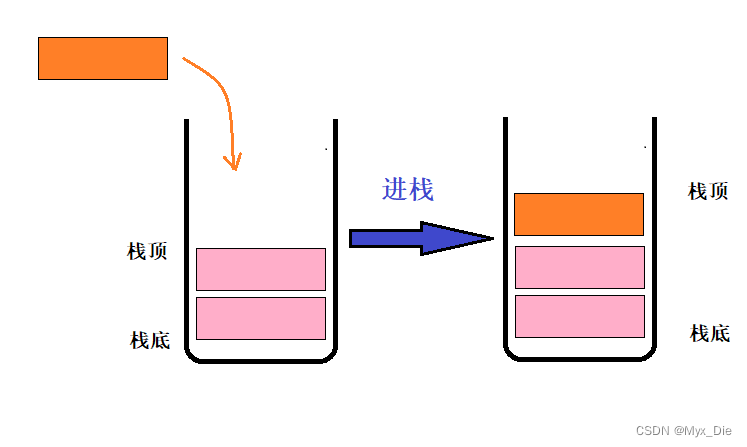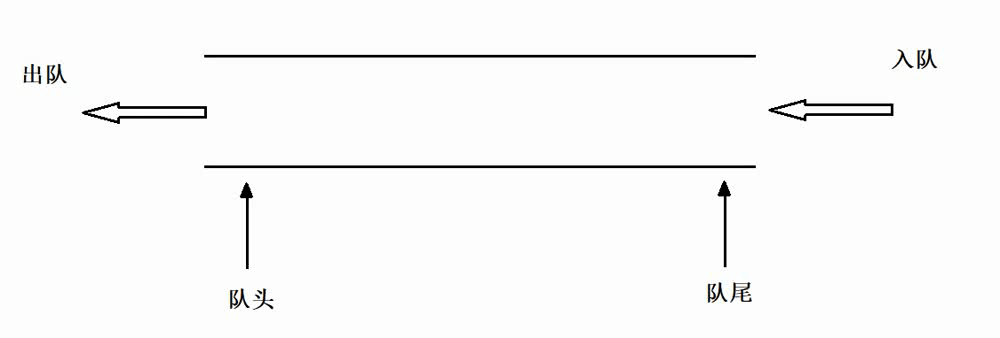一、栈的概念及结构
栈:一种特殊的线性表,其只允许在固定的一端进行插入和删除元素操作。进行数据插入和删除操作的一端称为栈顶,另一端称为栈底。栈中的数据元素遵守后进先出LIFO (Last ln First Out)的原则。
压栈:栈的插入操作叫做进栈/压栈/入栈。入数据在栈顶。
出栈:栈的删除操作叫做出栈。出数据也在栈顶。


二、栈的实现
栈的实现一般可以使用数组或者链表实现,相对而言数组的结构实现更优一些,因为数组在尾上插入数据的代价比较小。

下面是代码的实现,依然是建 3 个文件来实现栈的功能,如下:
Stack.h 文件:
#pragma once
#include <stdio.h>
#include <stdlib.h>
#include <assert.h>
#include <stdbool.h>
// // 静态
//#define N 10
//typedef int STDataType;
//typedef struct Stack
//{
// STDataType Data[N];
// int Top; // 标识栈顶的位置
//}ST;
// 动态
typedef int STDataType;
typedef struct Stack
{
STDataType* Data;
int Top; // 标识栈顶的位置
int Capacity; // 栈的容量
}ST;
// 初始化
void StackInit(ST* ps);
// 销毁
void StackDestroy(ST* ps);
// 插入\进栈\入栈
void StackPush(ST* ps, STDataType Data);
// 出栈
void StackPop(ST* ps);
// 取栈顶的元素
STDataType StackTop(ST* ps);
// 判断栈是否为空
bool StackEmpty(ST* ps);
// 计算栈里面的数据
int StackSize(ST* ps);Stack.c 文件:
#define _CRT_SECURE_NO_WARNINGS 1
#include "Stack.h"
// 初始化
void StackInit(ST* ps)
{
assert(ps);
ps->Data = NULL;
ps->Top = 0;
ps->Capacity = 0;
}
// 判断栈是否为空
bool StackEmpty(ST* ps)
{
assert(ps);
//if (ps->Top > 0)
//{
// return false;
//}
//else
//{
// return true;
//}
return ps->Top == 0;
}
// 插入\进栈\入栈
void StackPush(ST* ps, STDataType Data)
{
assert(ps);
if (ps->Top == ps->Capacity)
{
int NewCapacity = ps->Capacity == 0 ? 4 : ps->Capacity * 2;
STDataType* tmp = (STDataType*)realloc(ps->Data, sizeof(STDataType) * NewCapacity);
if (tmp == NULL)
{
perror("realloc");
exit(-1);
}
ps->Data = tmp;
ps->Capacity = NewCapacity;
}
ps->Data[ps->Top] = Data;
- ps->Top++;
}
// 出栈
void StackPop(ST* ps)
{
assert(ps);
// 栈为空不能再删
//assert(ps->Top > 0);
assert(!StackEmpty(ps));
ps->Top--;
}
// 取栈顶的元素
STDataType StackTop(ST* ps)
{
assert(ps);
assert(!StackEmpty(ps));
return ps->Data[ps->Top - 1]; // Top 初始值是 0,记录的是栈顶位置(栈顶元素+1位置)
}
// 计算栈里面的数据
int StackSize(ST* ps)
{
assert(ps);
return ps->Top; // Top 初始值是 0,记录的是栈顶位置(最后一个元素的下一个位置=>元素个数)
}
// 销毁
void StackDestroy(ST* ps)
{
assert(ps);
free(ps->Data);
ps->Data = NULL;
ps->Top = ps->Capacity = 0;
}StackTest.c 文件:
#define _CRT_SECURE_NO_WARNINGS 1
#include "Stack.h"
void Test1()
{
ST ps;
StackInit(&ps);
StackPush(&ps, 1);
StackPush(&ps, 2);
StackPush(&ps, 3);
StackPush(&ps, 4);
StackPush(&ps, 5);
while (!StackEmpty(&ps))
{
printf("%d ", StackTop(&ps));
StackPop(&ps);
}
printf("\n");
StackDestroy(&ps);
}
int main()
{
Test1();
return 0;
}三、队列的概念及结构
队列:只允许在一端进行插入数据操作,在另一端进行删除数据操作的特殊线性表,队列具有先进先出FIFO(First In First Out)
入队列:进行插入操作的一端称为队尾。
出队列:进行删除操作的一端称为队头。
动图如下:

四、队列的实现
队列也可以数组和链表的结构实现,使用链表的结构实现更优一些,因为如果使用数组的结构,出队列在数组头上出数组,效率会比较低。

下面是代码的实现,依然是建 3 个文件来实现队列的功能,如下:
Queue.h 文件
#pragma once
#include <stdio.h>
#include <stdlib.h>
#include <assert.h>
#include <stdbool.h>
typedef int QDataType;
typedef struct QueueNode
{
struct QueueNode* next;
QDataType Data;
}QNode;
typedef struct Queue
{
QNode* head; // 头位置
QNode* tail; // 尾位置
//int Size; // 在结构体里面定义 Size 入队\出队,改变 Size
}Queue;
// 初始化
void QueueInit(Queue* PQ);
// 检查
bool QueueEmpty(Queue* PQ);
// 入队
void QueuePush(Queue* PQ, QDataType Data);
// 出队
void QueuePop(Queue* PQ);
// 队列第一个数据
QDataType QueueFront(Queue* PQ);
// 队列最后一个数据
QDataType QueueBack(Queue* PQ);
// 计算个数
int QueueSize(Queue* PQ);
// 销毁释放
void QueueDestroy(Queue* PQ);
Queue.c 文件
#define _CRT_SECURE_NO_WARNINGS 1
#include "Queue.h"
// 初始化
void QueueInit(Queue* PQ)
{
assert(PQ);
PQ->head = PQ->tail = NULL;
}
// 检查是否为 NULL
bool QueueEmpty(Queue* PQ)
{
assert(PQ);
return PQ->head == NULL; // 判断 head 或者 tail 是否为 NULL 都可以
}
// 入队
void QueuePush(Queue* PQ, QDataType Data)
{
assert(PQ);
QNode* Newnode = (QNode*)malloc(sizeof(QNode)); // malloc 的是结点(QNode),类型千万别弄错
if (Newnode == NULL)
{
perror("malloc");
exit(-1);
}
Newnode->Data = Data;
Newnode->next = NULL;
if (PQ->head == NULL)
{
PQ->head = PQ->tail = Newnode;
}
else
{
PQ->tail->next = Newnode;
PQ->tail = Newnode;
}
}
// 出队
void QueuePop(Queue* PQ)
{
assert(PQ);
assert(!QueueEmpty(PQ));
// 如果只剩最后一个结点,此时 head、tail 的 next 都是 NULL, 再删的话 tail 就成野指针了
// assert(PQ->head->next);
if (PQ->head->next == NULL)
{
free(PQ->head);
PQ->head = PQ->tail = NULL;
}
else
{
QNode* next = PQ->head->next; // next 的类型也是 QNode*
free(PQ->head);
PQ->head = next;
}
}
// 队头的数据
QDataType QueueFront(Queue* PQ)
{
assert(PQ);
assert(!QueueEmpty(PQ));
return PQ->head->Data;
}
// 队尾的数据
QDataType QueueBack(Queue* PQ)
{
assert(PQ);
assert(!QueueEmpty(PQ));
return PQ->tail->Data;
}
// 计算个数
int QueueSize(Queue* PQ)
{
assert(PQ);
int temp = 0;
QNode* cur = PQ->head; // 定义指针 cur 遍历队列,类型也是 QNode*
while (cur)
{
temp++;
cur = cur->next;
}
return temp;
}
// 销毁释放
void QueueDestroy(Queue* PQ)
{
assert(PQ);
QNode* cur = PQ->head;
while (cur)
{
QNode* next = PQ->head->next;
free(cur);
cur = next;
}
PQ->head = PQ->tail = NULL;
}QueueTest.c 文件
#define _CRT_SECURE_NO_WARNINGS 1
#include "Queue.h"
void Test1()
{
Queue pq;
QueueInit(&pq);
QueuePush(&pq, 1);
QueuePush(&pq, 2);
QueuePush(&pq, 3);
QueuePush(&pq, 4);
QueuePush(&pq, 5);
while (!QueueEmpty(&pq))
{
printf("%d ", QueueFront(&pq));
QueuePop(&pq);
}
printf("\n");
QueueDestroy(&pq);
}
int main()
{
Test1();
return 0;
}以上就是 栈和队列的概念、结构及其实现,我在 栈 和 队列 的测试文件里面,我全部写好去简单测试了一下,建议每写一个功能去测试运行一下,有错误可以及时改。





















 740
740











 被折叠的 条评论
为什么被折叠?
被折叠的 条评论
为什么被折叠?








